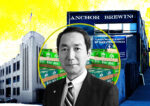Trending
Planes, frames and automobiles
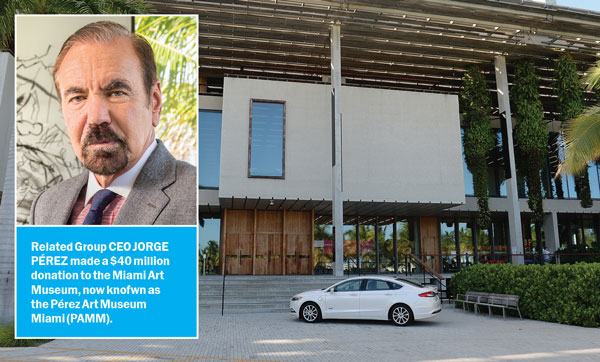
When it comes to partying, Miami gives Vegas a real run for its money. And when it comes to showing off wealth in grand fashion, Miami’s top real estate players surely do it best. Despite the manic ups and downs of the past couple of real estate cycles — the current one being no exception — the bravado of these bigwigs has never faltered.
The personal residences of Miami’s real estate moguls are as over the top as their fortunes will allow. Russell Galbut, CEO of development company Crescent Heights, believes in putting his money where his mouth is. He made his fortune in South Beach real estate. His mammoth 17,000-square-foot personal residence, which was completed in the summer of 2016 on Alton Road in the South of Fifth neighborhood, sits atop a robotic parking garage where cars are hydraulically lifted to their respective spaces. Galbut’s residence begins on the third floor, going up four floors in a configuration that includes rooftop terraces, an infinity edge pool, a waterfall and a racquetball court.
Over on Star Island, Stuart Miller, CEO of homebuilder Lennar, is building big. He owns 22 Star Island, which includes a mansion dating back to 1931 that he moved elsewhere on the property to make room for a new structure. He is also in the midst of construction at 11 Star Island, where a mammoth 120,000-square-foot property is taking shape. It will include a lagoon and waterfall in addition to underground parking that will accommodate 32 cars. The homes are reportedly for his personal use.

Jill Hertzberg, one half of Coldwell Banker’s power broker team the Jills, said many of her high-net-worth clients have homes that include the kind of over-the-top amenities that cost way more to build than they actually add in value to the properties. She pointed specifically to the trend of amped-up garages that feature hydraulic lifts for sports cars in “huge glass enclosures.” Hertzberg added that these well-heeled clients rarely spend an entire year in their South Florida residences.
Luis Navas, managing partner of Global Governance Advisors, a Miami-based company advising on executive compensation, said, “The usual big expenses for some of my real estate clients are second, third and fourth homes in New York or out west. Many of them live in Florida for six months and one day so they are taxed as a Florida resident.”
But that isn’t the case for homegrown Turnberry Associates co-CEO Jeffrey Soffer. His home at 27 Indian Creek Island Road, which until recently he shared with his then-wife, former supermodel Elle Macpherson, is a spectacular 25,600-square-foot oceanfront property and his primary residence. The Mediterranean-style estate has nine bedrooms, 11 bathrooms and a private dock. There are only about three dozen other homes on Indian Creek Island, and they’re owned by some of America’s wealthiest people, including activist investor Carl Icahn and car dealership mogul Norman Braman.
In addition to his opulent home, Soffer can claim the prize for coolest private celebration. He hired Prince to perform at his 40th birthday party 10 years ago. It was a considerable coup for quite a few reasons, the first being that the late rock star was hardly a regular fixture on the private-party-for-hire circuit, and his $2 million asking price was just part of the cost for the show, which opened with KC & the Sunshine Band and re-created an entire nightclub at Turnberry Aviation’s hangar at the Opa-locka Executive Airport.
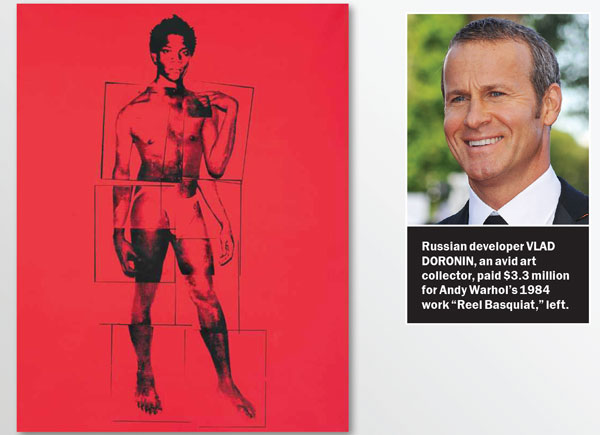
Artistic sensibilities
While some real estate billionaires may choose costly blowouts with no appreciable return, others spend their cash on expensive interests in which the returns are measured in legacy value rather than dollar amounts.
Jorge Pérez, developer and co-founder of the Related Group, is often referred to as Miami’s condo king, with a net worth estimated at $3 billion. He was born to Cuban parents living in exile in Argentina and grew up there and in Colombia. Pérez told Forbes: “In America you are judged by what you accomplish. In Latin America you are judged by who your family is.” That sentiment might explain why he made a $40 million donation to the Miami Art Museum ($20 million worth of art from his own collection and $20 million in cash), which now bears his name.
Since the financial crash of 2008 and a cancer scare, Pérez says, he has dedicated his life to his art and philanthropy. In contrast to his billionaire real estate pals, Pérez told Architectural Digest in 2014, referring to his collection: “I don’t buy boats or planes. This is my passion.”
Russian developer Vlad Doronin, who owns a personal residence on Star Island, may be known to most as the billionaire former boyfriend of supermodel Naomi Campbell. He is also, according to the Miami Herald, an avid art collector. Works he owns include Russian avant-garde paintings from Kazimir Malevich and El Lissitzky as well as art by contemporary masters including Jean-Michel Basquiat, Ed Ruscha and Anish Kapoor. In 2011, he paid $3.3 million for Andy Warhol’s 1984 painting “Reel Basquiat.” Doronin’s advisors reportedly include New York gallerist Tony Shafrazi.
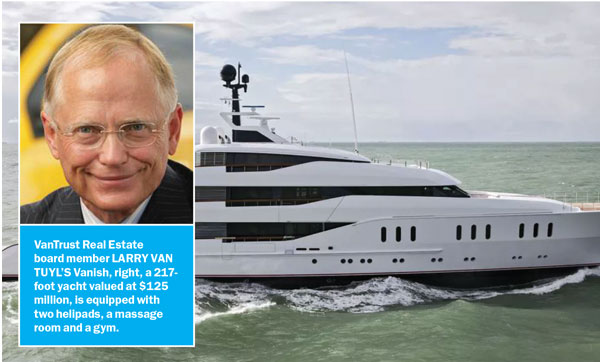
Staying afloat
It would be impossible to mention Miami’s well-heeled without talking about their yachts.
Only serious players can get into the game on the upper end. Often docked at One Island Park Marina, on Terminal Island off the MacArthur Causeway, is the 217-foot boat Vanish. It’s owned by billionaire Larry Van Tuyl, a board member of VanTrust Real Estate and owner of industrial real estate in Florida and throughout the U.S. The vessel is valued at around $125 million and is equipped with two helipads, an outdoor cinema, a gym, a sauna, a massage room and a freestanding staircase flanked by a glass wall over three decks.
Docked over at Watson Island Gardens Marina off the MacArthur Causeway in Miami is the 377-foot-long Luna, sold by Russian billionaire investor Roman Abramovich to his friend Farkhad Akhmedov. The boat was last valued at $545 million and features two helipads and anti-drone technology, which renders drones flightless from 2 kilometers away.
Plane to see
Along with yachts come the obligatory personal jets. Kevin Maloney, the founder and principal of Property Markets Group, lives in Miami, though he does much of his development in New York. He flies his private jet to and from the two cities, telling TRD that he first got into piloting to get over his fear of flying.
What is a private jet with gold-plated fixtures, estimated by some to be worth $60 million, really worth when it belongs to Phillip Frost, a man who made billions selling pharmaceutical companies? The largest shareholder in Vector Group, the parent company of Douglas Elliman, also has a 6-acre residence at 21 Star Island, last valued at $52 million.
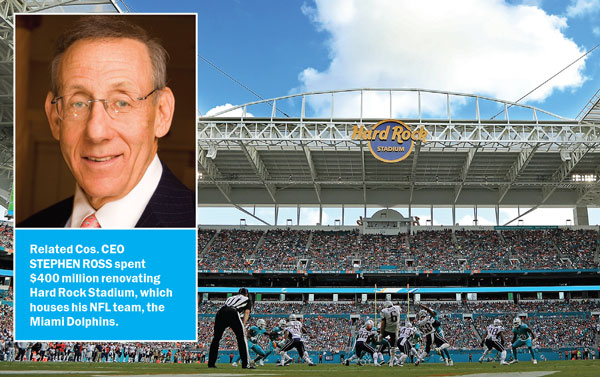
They’ve got game
As well as being a party town, Miami is a sports town, and owning franchises appears to be the Achilles’ heel of many billionaires. They are particularly risky ventures because of the costs of recruiting players and paying their multimillion-dollar salaries along with loans and upkeep of stadiums. It’s a money pit unless the team is offsetting costs by constantly winning and selling enough merchandise, TV rights and advertising, experts said.
But many billionaires are, by nature, risk takers. Thus, the chairman of the Related Companies, Stephen Ross, in between overseeing the development of the $15 billion Hudson Yards project in New York, has committed $400 million of his own money to renovating Hard Rock Stadium, home to his NFL team, the Miami Dolphins.
The most valuable sports franchise in the world is the Manchester United soccer team, which plays in the English Premier League and is reportedly worth over $1 billion. It is owned by the Glazer family, whose deceased patriarch, Malcolm Glazer, made his fortune in Palm Beach real estate before investing in sports teams. He paid $192 million for the Tampa Bay Buccaneers in 1995. Today, First Allied Corporation, the real estate holding company owned and run by his children, has 6.7 million square feet of real estate, according to its website.
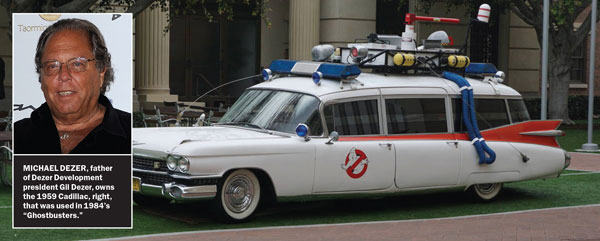
Fast car
Some say no South Florida developer exemplifies opulence and extravagance more than Gil Dezer. His firm Dezer Development has built high-rises in Sunny Isles Beach including the 60-story Porsche Design Tower with its “Dezervator,” a patented car elevator carrying the developer’s name. It takes vehicles and their owners up to any of the building’s 132 condos. Dezer’s own car collection, with a value estimated to be in the region of $20 million, includes a $1.5 million Bugatti Veyron, only one of 450 that exist. However, each of his cars pales in comparison to the developer’s $17 million Gulfstream IV private jet. All the cars and jets are finished in Dezer’s favorite color, silver. And his plane was custom-fitted with seats similar to those in his Ferrari 458 Italia, at a cost of $55,000 each.
As with his start in real estate, Gil Dezer got his love of cars from his father, developer Michael Dezer. The elder Dezer has his own museum (the Dezer Collection Museum and Pavilion) dedicated to his pricey cars in North Miami. Amongst the vintage rides are Chryslers and Mustangs along with microcars not often associated with real estate tycoons, including Citroëns, Fiats, DAFs and Sabras. The museum has an indoor drive-in movie theater and a Hollywood wing that includes the 1948 Ford from “Grease,” the 1959 Cadillac Ecto-1 from “Ghostbusters” and, of course, the 1981 DeLorean from “Back to the Future.” There are numerous Batmobiles “from all eras, including one built by George Barris,” claims the website. There’s also a James Bond collection including cars from recent 007 films, like a shot-up Land Rover from ‘Skyfall,” as well as Aston Martins that date back to ’60s-era Bond films.
Forbes estimates the 1,000-car collection to be worth around $30 million. The museum is a pure vanity project and doesn’t turn a profit, although tickets are priced at $40 for adults and $15 for children. Michael Dezer started his real estate career buying and selling properties in Chelsea in Manhattan in the 1980s before developing ocean-front properties with Donald Trump bearing the now-president’s name. He characterized his collecting ethos by simply saying: “If I see something I like, I buy it.”


